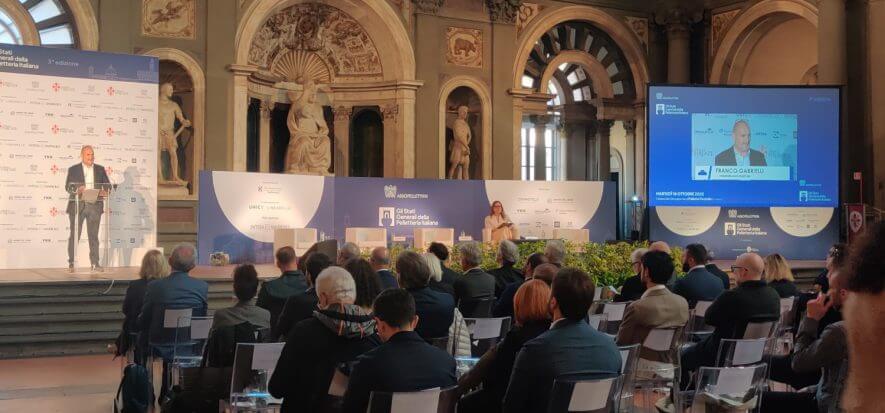Creating aggregation, receiving focused incentives from the Government, promoting the made-in-Italy industry. These are the three actions identified by Assopellettieri (association part of Confindustria Moda) to support the segment and looking to the future. The message came in occasion of the third edition of Stati Generali della Pelletteria Italiana, held on October 18th inside the Salone dei Cinquecento at Palazzo Vecchio in Florence. And event that this year also partnered with The European House – Ambrosetti and was done in collaboration with UNIC – Italian Tanneries and Lineapelle. “The association is an insurance on the lives of businesses – said Franco Gabbrielli (in photo), president of Assopellettieri, while speaking on the stage -. To achieve this goal, that of looking forward, everybody’s participation is needed”.
Non-stop growth: forecast for 100 billion
Italy’s leather goods segment increased global sales constantly throughout the years (with the exception of 2020). From 56 billion USD of 2019 to 64 in 2021. 2022 is expected to close with 72 billion in turnover, while the 100-billion mark should be reached in 2027. Even if the data is positive, “Italy doesn’t have the right perception of itself – explained Flavio Sciuccati, Senior Partner and Director Global Fashion Unit, The European House Ambrosetti -. This is a segment that should feel like a swan and not the ugly duck”. Improving the storytelling would mean giving value to the leather goods segment, in order to also favor the external perception.
Ambrosetti’s strategic study
What emerged from Ambrosetti’s strategic study is that Italy’s leather goods segment gives value to the country and gives work to many people, with a very positive result. The chain employs 145,706 people in Europe and has one of the most positive budget balances within manufacturing. The country’s reputation is the real risk for competitivity: Italy sits 17th in Europe for the Corruption Perception Index ranking (CPI).
How is Italy’s leather goods segment changing
Among the trends bringing change to the leather goods segment of Italy are, first of all, the decrease in number of companies with their own brands, both from a size and revenue standpoint. On the opposite, the number of companies acting as third-party producers has gone up, with consequent increases of revenue and sizes. These entities are well equipped and ready for the challenges of the global marketplace. “The association must defend small businesses with their own brand, as they have always been the backbone of the districts”, commented Gabbrielli. Another data point that emerges is that margins in Italy are much lower than they are in Spain and France. There is an average 10% margin in Italt, while in France it’s 20%. Additionally, there is the matter of aggregations at different levels.
Three actions
With regards to the three actions to take, one is tied to politics. Because as points out Gabbrielli, companies can’t be left to fend for themselves. “We are entrepreneurs, and we are used to solving problems quickly, but we need politicians that intervene. We can’t go on by ourselves”. On the matter of energy, education and sustinability, the State has been called to action. “It’s not acceptable that in this fragmented segment companies are left to manage all issues by themselves”, added Sciuccati.
Supply chain
The day closed with a focus on supply chain, as well as insights on new business models, sustainability and education. Speakers included Marco Palmieri, president and CEO of Piquadro Group, and Stefano Giacomelli, CEO of Tivoli Group. Then Andrea Cottini, COO of Bottega Veneta, and Fulvia Bacchi, CEO Lineapelle and general manager of UNIC- Italian Tanneries. “If we discuss appeal, the tanning segment isn’s perceived as positive, but we are working hard to change that by educating people – stated Bacchi -. We work on educating children when they are in elementary school, involving the kids in activities done in schools near tanning districts across the country”.










